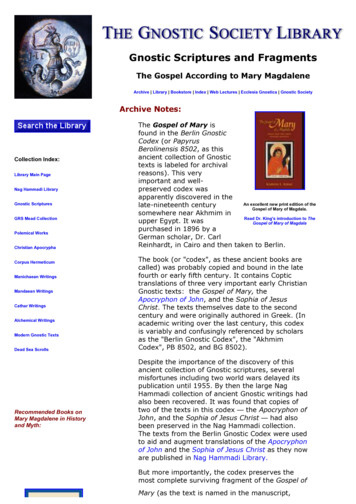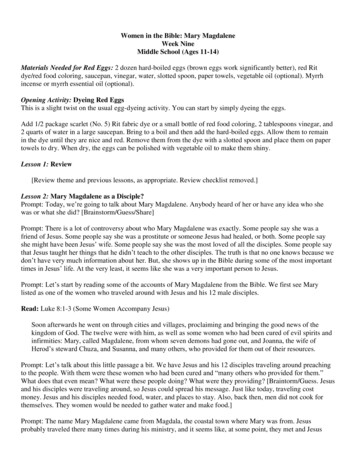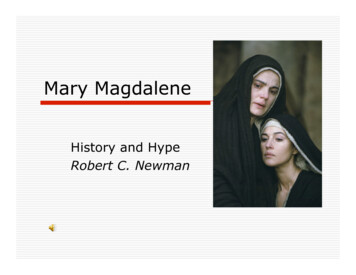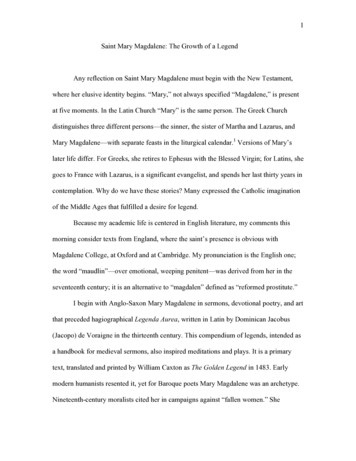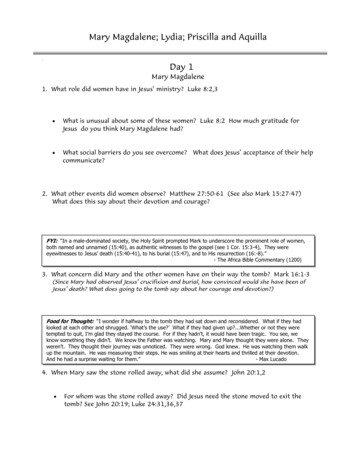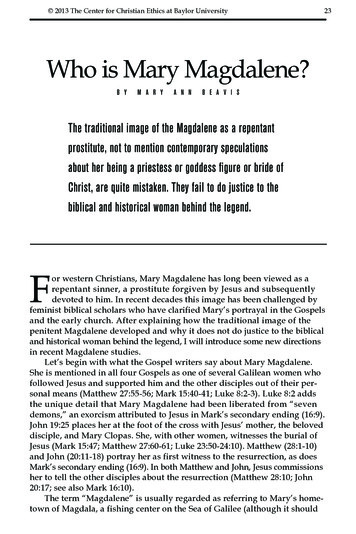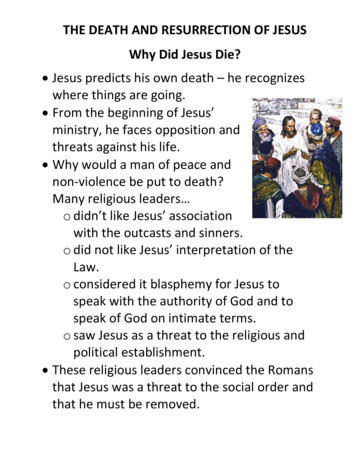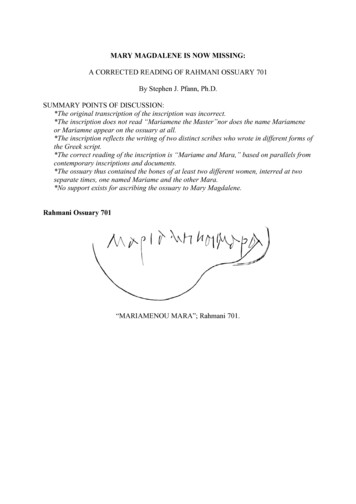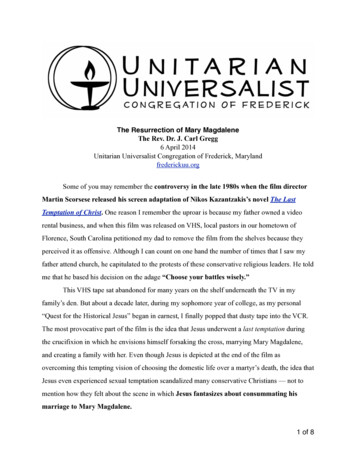
Transcription
The Resurrection of Mary MagdaleneThe Rev. Dr. J. Carl Gregg6 April 2014Unitarian Universalist Congregation of Frederick, Marylandfrederickuu.orgSome of you may remember the controversy in the late 1980s when the film directorMartin Scorsese released his screen adaptation of Nikos Kazantzakis’s novel The LastTemptation of Christ. One reason I remember the uproar is because my father owned a videorental business, and when this film was released on VHS, local pastors in our hometown ofFlorence, South Carolina petitioned my dad to remove the film from the shelves because theyperceived it as offensive. Although I can count on one hand the number of times that I saw myfather attend church, he capitulated to the protests of these conservative religious leaders. He toldme that he based his decision on the adage “Choose your battles wisely.”This VHS tape sat abandoned for many years on the shelf underneath the TV in myfamily’s den. But about a decade later, during my sophomore year of college, as my personal“Quest for the Historical Jesus” began in earnest, I finally popped that dusty tape into the VCR.The most provocative part of the film is the idea that Jesus underwent a last temptation duringthe crucifixion in which he envisions himself forsaking the cross, marrying Mary Magdalene,and creating a family with her. Even though Jesus is depicted at the end of the film asovercoming this tempting vision of choosing the domestic life over a martyr’s death, the idea thatJesus even experienced sexual temptation scandalized many conservative Christians — not tomention how they felt about the scene in which Jesus fantasizes about consummating hismarriage to Mary Magdalene.1 of 8
Overall I found the film to be a fascinating speculation about what it means to believethat Jesus was fully human, just like the rest of us. And more recently, a few years ago whilelistening to the contemporary wisdom teacher Cynthia Bourgeault speak about her 2010 bookThe Meaning of Mary Magdalene, I thought to myself that, perhaps the “The Last Temptation ofChrist” should be retitled “The Best Temptation of Christ.”Whereas many religious traditions uphold celibate monasticism as the ideal, Bourgeault(who is inspired by the Mary Magdalene tradition) argues, for an understanding of humanrelationships as an equally transformative “sacred path” (216). If you are called to celibacythat can and has been transformative for many, but so too can relationships and marriage. Andperhaps if the Romans had not executed Jesus for insurrection, he might have married MaryMagdalene and had children. And a whole new set of teachings might have emerged from thatbond. As anyone who has ever been in a longterm relationship can attest, Jesus’s teaching to“love your neighbor” is easier in the abstract and in the short term (Jesus was itinerant!) thanloving one particular person day after day, after day for the rest of your life (as well as remaininglovable yourself). And although there is tremendous value in many parts of Jesus’s life andteachings, for anyone discerning how to love another person for a lifetime, Jesus — who diedtragically young and single at around the age of 30 — is not our best marriage counselor.That being said, one major emphasis of our Unitarian Universalist heritage is the teachingthat Jesus is fully human — and that to whatever extent Jesus manifested the sacred or thedivine, we too have that same potential. As one Jewish feminist biblical scholar has written,taking into account all that we know in the early twenty-first century, our invitation to still“value Jesus [even] if he was just a Jew who chose to emphasize certain ideas and values inthe Jewish tradition but did not invent or have a monopoly on them” (122).And if Jesus was fully human, that means that there was a sexual component to his being.As the poet William Blake (1757-1827) said more than two centuries ago: “The Bible must beshaken upside down before it will yield all its secrets. The priests have censored and clippedand mangled: they give us a celibate Jesus born of a virgin without the slightest ‘stain’ ofsexual contact, which is blasphemes nonsense” (29). I love that what Blake deems2 of 8
blasphemous is not Mary Magdalene as the last/best temptation of Christ; rather, for Blake, theblasphemy is neutering Jesus.And I invite you to consider that the consistent fascination with Mary Magdalene throughthe centuries is because Mary Magdalene reminds us of a huge shadow side of the Christiantradition: the repression of both women’s experience in particular and of sexualitygenerally. Along these lines, my sermon title this morning is inspired by the landmark book bythe feminist biblical scholar Jane Schaberg from about a decade ago titled The Resurrection ofMary Magdalene. Following the trajectory of Schaberg’s work, I would like to invite us toconsider what it might look like to reconsider the Christian tradition from the perspective ofwomen’s experience, using Mary Magdalene as our guide.I’ve also shared with you before about my interest in the work of the religion scholarJeffrey Kripal, who teaches at Rice University in Houston. Kripal has written about hisexperience that was similar to the “Last (or best!) Temptation of Christ.” Just as those fictionalworks imagine Jesus having a vision of escaping his crucifixion to start a family with MaryMagdalene, Kripal, while he was in seminary to become a Roman Catholic priest, had a powerfuldream in which he was swimming and had to choose which side of the river to swim toward. Onone side was Jesus. On the other side was a beautiful woman.The dream forced him to confront in a way that he had not previously that his sexualitywas a central part of himself and his spirituality that he could not repress. But given the current“symbolic and institutional system” of Roman Catholicism (which allows only celibate males toascend to the highest ranks of religious leadership), he saw his choice as drawn starkly “betweena celibate religious or a secular [heterosexual] life.” Here we can see the long shadow of therepressed Magdalene archetype within the Christian tradition: There was no room for him as aself-described “active, heterosexual male” within a Roman Catholic seminary. Accordingly, hewrote in his journal: “This is just perfect — I’m caught between a sexless Virgin and ahomoerotic Jesus” (155).I don’t quote that last line to be offensive. Rather, I am very seriously inviting us toconsider the dynamics of the Christian tradition given what we know about modernpsychoanalysis. From a post-Freudian perspective, Kripal’s dream was his unconscious3 of 8
confronting him an aspect of himself he had been repressing. Freud calls this sublimination. AsMark Jordan (who grew up gay and Catholic and is now a Professor of Christian Thought atHarvard) has written, there is a “paradox created by an officially homophobic religion inwhich an all male clergy sacrifices male flesh before images of God as an almost nakedman.” There is a lot more to be said about this insight — and many more examples that I couldgive at another time, particularly in the writings of the Christian mystics through the ages — butfor now suffice is to say that if you take one step back to observe the religious landscape, thereare unavoidable, unconscious psycho-sexual dynamics that are in play when one is part of areligion in which one is commanded to love a God, who is always pictured as male. Andthat unconscious relationship to the male deity plays out differently, depending on whereyou find yourself on the spectrum of masculine and feminine, heterosexual or homosexual.And as Kripal moved away from his pursuit of the priesthood and toward academia, hisscholarship led him to a study of the Hindu tradition which has a strong component of embracinga scared heterosexuality — as can be seen in the Tantric tradition, books such as the Kama Sutra,and the explicit carvings on the sides of many Temples.Returning to our guide of Mary Magdalene, she also challenges us about howproblematic it is to put a single male at the center of a religious tradition. Such a choice almostinevitability leads both to sexism (the favoring of the male) and to individualism. Indeed,feminist scholar Elisabeth Schüssler Fiorenza has argued that as important as the Quest for theHistorical Jesus has been, it still troublingly puts all the focus on the identity of one man(11).And the orthodox reading of the Christian tradition is that an asexual Jesus passed on themantle of leadership to a series of celibate males at the head of a top-down hierarchy. But thereare many other ways of interpreting Christianity history. We have only to consider verses such asMatthew 8:14 to see that, “When Jesus entered Peter's house, he saw his mother-in-law lying inbed with a fever.” The last time I checked, the only way you get a mother-in-law is to getmarried. So if Peter was the “first pope,” then the first pope had a wife.And if you read the Gospel of John, the “Beloved Disciple” is depicted as a moreimportant leader than Peter. If you read the Book of James, Jesus’s brother James seems like the4 of 8
primary leader after Jesus’s death. Likewise for Paul’s letters (he seems most important there)and the same for the Gospel of Thomas or the Gospel of Mary; therein the primary leader seemsto be Thomas or Mary respectively. As you begin to separate out these competing claims ofauthority, the question becomes, in the words of the historical Jesus scholar John DominicCrossan, “How Many Years Was Easter Sunday” (190)? What he means is the traditionsaround “Easter” were not one story of one morning told and retold in an unchanging way untiltoday, but were rather decades in the making — both for the date of Easter (which seems not tohave been set until at least a full century after Jesus’ death) and for the stories about Jesus’resurrection which were formed in the telling and retelling as his various followers struggled tomake sense of his death. And these stories were told in different ways by the differentcommunities of Jesus followers that gathered around Peter, James, John, Mary, Thomas, andother competing leaders in the wake of Jesus’s death.As the Harvard historian of religion Karen King puts it in her book The Gospel of MaryMagdala:The beginning is often portrayed as the ideal to which Christianity should aspireand conform. Here Jesus spoke to his disciples and the gospel was preached intruth. Here the churches were formed in the power of the Spirit and Christianslived in unity and love with one another. But what happens if we tell the storydifferently? What if the beginning was a time of grappling andexperimentation? What if the meaning of the gospel was not clear andChristians struggled to understand who Jesus was.?” (158)And although it was indeed the case that there was “Original Diversity” at the beginning of theChristian tradition, if we pay attention to the role of Mary Magdalene, it is fascinating to notethat all four canonical Gospels — Matthew 28, Mark 16, Luke 24, John 20 — agree that womenwere the first to learn about Jesus’s missing body, and women were the first to proclaim the storyof the Resurrection. Why the women? Because the men were in hiding behind closed doors! Forthis role, Mary Magdalene has been called the “Apostle to the Apostles.” So, one could ask, if awoman preached the first Easter sermon, how can one possibly be against the ordination of5 of 8
women?! (The answer is to stay in a patriarchal bubble in which all biblical interpretation isdone by men and for men.)But the role of women in the Christian tradition could never been fully covered up oreliminated: “In Western Europe, over 190shrines were dedicated to Mary Magdalene,and more than 600 of her relics venerated. InReformation England, there were 170churches bearing her name” (50). Indeed, onthe living room wall of my grandmother who wasa lifelong Southern Baptists was a collection ofthree prominently placed pictures: two aretraditional “Madonnas” of the Virgin Mary, onein all black for mourning, one is wearing thetraditional blue associated with Mary. But thethird — wearing bright red — is clearly aMagdalene. My grandmother inherited these pictures from two of her older sisters. To me, theyare yet one more testimony to the search for the missing element of women’s experience andleadership in the Christian tradition, which thankfully is changing more rapidly in recentdecades.But in reclaiming women’s experience in the Christian tradition, feminist scholars rightwarn against a naïve perspective that there was some perfect egalitarianism in the beginning ofthe Jesus tradition that was then corrupted by the patriarchy. Rather, scholars such as SchüsslerFiorenza invite us to consider that there has always been an ongoing struggle for equality andcommunity over against domination and control (199).If that is the case, how should we adjudicate between all the incredibly diverse andconflicting claims that individuals and groups make about Jesus and the Christian tradition?Melanie Johnson-Debaufre, a student of Schüssler-Fiorenza, argues that the criteria for choosingshould be a pragmatic one: if the way someone is teaching and practicing Christianitycontributes toward the “liberation and dignity of all people,” then we should support it.6 of 8
Conversely, if the way someone is teaching and practicing Christianity leads to domination andcontrol (especially of individual men over women or over minority groups), we should oppose it(200).To use a Buddhist metaphor along these lines, arguably the greatest error in theChristian tradition has been “mistaking the finger pointing at the moon for the moon.”When we look at Jesus’s own life and teachings — as opposed to the ways he was deified byothers after his death — we don’t see Jesus pointing to the importance of his own person or thesignificance of his future martyrdom. Rather, in the first chapter of the Gospel of Mark, theearliest of the canonical Gospels, we read, “Jesus came to Galilee, proclaiming the good news ofGod, and saying, ‘The time is fulfilled, and the kingdom of God has come near; repent, andbelieve in the good news’” (Mark 1:14-15). Note that the good news Jesus is proclaiming inhis public ministry is not that he is going to die on the cross in a few years. Instead, he ispointing beyond himself to what he called the “kingdom of God” — or what we can call the“Beloved Community,” following The Rev. Dr. Martin Luther King, Jr. But far too often theChristian tradition has stumbled over the identity of Jesus or made an idol of the Bible —thereby confusing the pointing finger with the moon — when the most important point hasnever been either Jesus or the Bible, but rather how both Jesus and scripture point us awayfrom ourselves and our narcissism and redirects us toward building the BelovedCommunity both then and now (201).The reason I chose to preach this morning about “The Resurrection of Mary Magdalene”is to: refocus our attention away from all the debates about the identity of Jesus (who isultimately just one individual male); remind us that salvation is much less about what anyone believes about what happened twothousand years and much more about whether you seek justice, kindness, and compassionhere and now; turn our attention toward the building of a diverse Beloved Community that dares totransgress traditional boundaries of race, gender, sexuality, and class.7 of 8
Reconsidering the Christian tradition from the perspective of Mary Magdalene challenges us todemand a spirituality that is worthy of our whole selves. And she — the “Apostle to theApostles” on that first Easter morning — reminds us that the final truth of Easter turns onwhether we will recommit ever anew to the hard, risky, but vital work of building the belovedcommunity: of working each day within ourselves, in our intimate relationships, and in ourcommunities for rebirth, renewal, and resurrection.8 of 8
The Resurrection of Mary Magdalene The Rev. Dr. J. Carl Gregg 6 April 2014 Unitarian Universalist Congregation of Frederick, Maryland . listening to the contemporary wisdom teacher Cynthia Bourgeault speak about her 2010 book The Meaning of Mary Magdalene, I thought to myself that, perhaps the "The Last Temptation of
